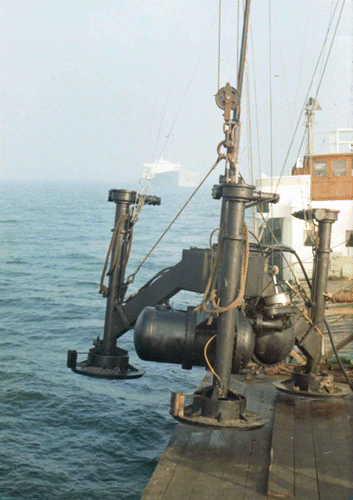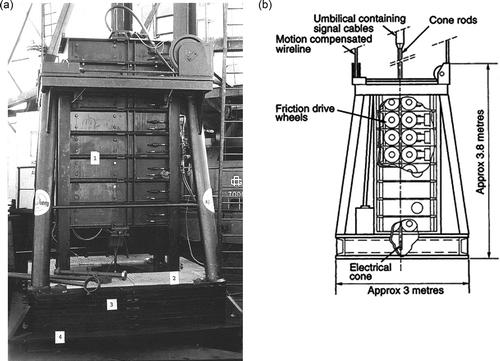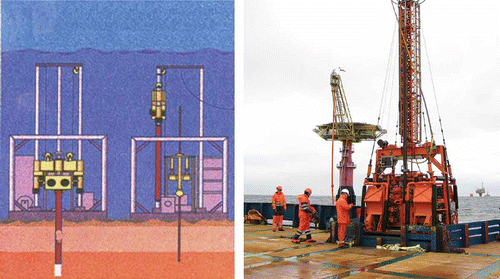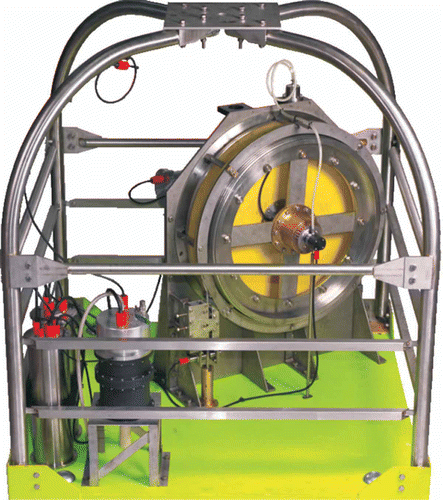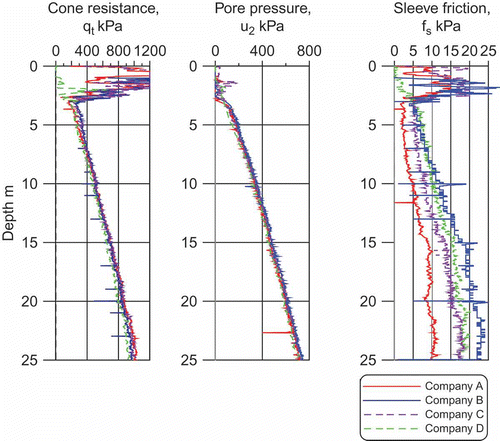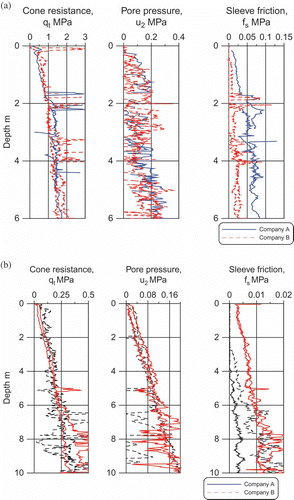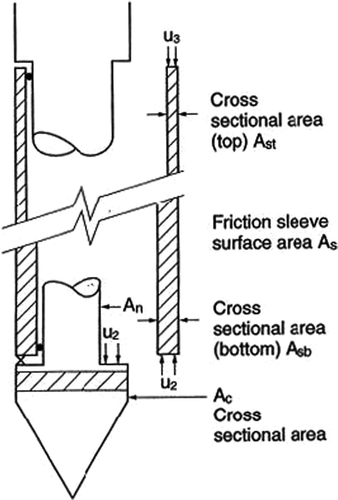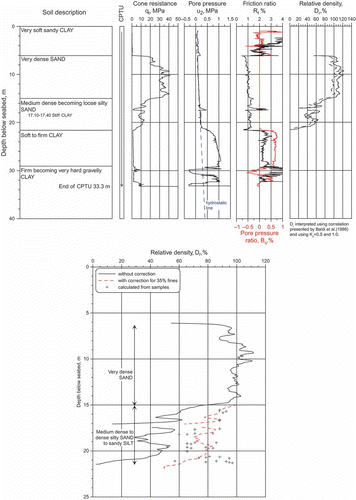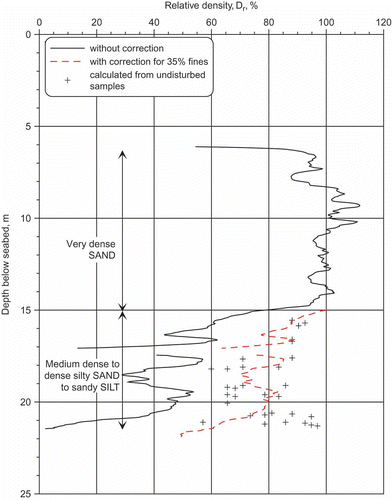Abstract
For the last 40 years, the CPT has played a key role in offshore soil investigations, mainly in connection with oil and gas development, but also for other purposes. The offshore application of CPT has been an important factor with regards to development of equipment, data processing and interpretation. Each of the following aspects are discussed in terms of historic development, present status and future challenges:
- Deployment method and equipment.
- Penetrometer design and construction.
- Data acquisition, processing and quality control.
- Standards and guidelines.
- Interpretation of results and application in foundation design.
It is shown that these developments have greatly enhanced the reliability and applicability of the use of the CPT in soil investigations and design. However, there are still important challenges to be faced in the future
Keywords:
1. Introduction
Cone penetration testing (CPT) has been an essential part of offshore soil investigations for four decades, and significant developments have taken place in this period. In most parts of the world it is hardly possible to consider an offshore soil investigation without the use of the CPT, and the results are essential input in establishing the soil profile and soil parameters for foundation design. Most of the developments have been in response to requirements from the oil and gas industry, where the main challenges have been to cover deeper water and harsher and more remote areas. As an example, shows how the water depth capabilities in offshore exploration drilling have evolved over the last 50 years.
Figure 1. Worldwide progression of water depth for offshore drilling (adapted from [email protected]).
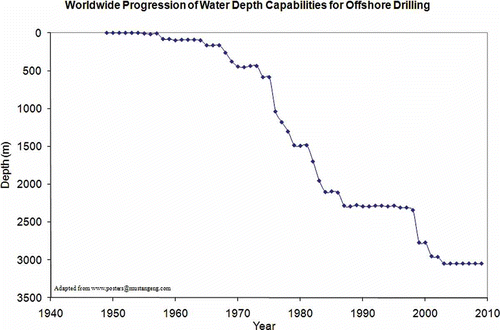
These changes have meant that oil and gas projects have evolved from piled jacket structures or jack-up platforms in the first years to new types of structures such as gravity base platforms, floating structures and seabed structures anchored by suction piles.
Geohazard assessment has also become more important with increasing water depth, requiring a range of parameters that can fully or partly be determined from in situ tests. The difficulty of taking high quality samples in deep water has also been a factor for increased use of in situ tests.
The focus of this paper is on soil investigations in water depths greater than 10--15 m where the testing is typically done from some floating barge or vessel. Further, the emphasis is on the CPT with add on sensors. Other in situ tests, such as vane, pressuremeter and dilatometer are not discussed.
2. Deployment of penetrometers
2.1 Introduction
It is outside the scope of this paper to go into specific details of vessels or working platforms. However, there has been a significant development from the old vessel Explorer, which was a rebuilt whaling ship with the drill rig cantilevering from the aft deck and 4-point mooring, to the specialized drill ships used to-day with a moonpool and dynamic positioning (DP).
There are basically two ways of pushing a cone penetrometer into the sea bottom (e.g., Zuidberg et al. Citation1986, Lunne Citation2001):
| • | By pushing from the sea floor until refusal, or a predetermined penetration; this has traditionally been called seabed mode. | ||||
| • | By drilling a borehole and pushing the penetrometer into the soil at bottom of the borehole; this is usually called down-hole mode or drilling mode. | ||||
With the arrival of seabed-based drilling machines, it has been necessary to modify the terminology used. A new ISO standard under preparation (see Section 5) addresses this change. However, since the new terminology is not currently finalized (as of March 2010), the traditional terminology, as defined above, will be used here.
2.2 Penetration from seabed
In many cases, seabed-mode testing will be the most cost effective solution and give the highest quality results (e.g., Peuchen Citation2000). In favourable conditions, 40–50 m penetration below seabed can be achieved.
The Dutch company Fugro early identified the need to develop a seabed rig, and in 1966 they started the design which resulted in the Seabull rig (Zuidberg Citation1972). This rig, as shown in , was found cumbersome to operate and it was mainly used in estuaries and very shallow waters. Subsequently, in 1972 Fugro used the experience from the Seabull to develop a more simple and robust rig; this was called the Seacalf (Zuidberg Citation1972, 1974). With the Seacalf, shown in , practical working tool had been developed. By mid 1974, Zuidberg (Citation1975) reported that about 500 tests had been performed in the northern North Sea.
Figure 3. Fugro's Seacalf rig (from Zuidberg Citation1974).
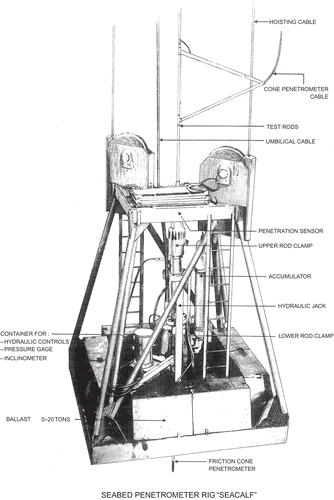
It is interesting to note that at about the same time as the first Seacalf tests were carried out, Norwegian Geotechnical Institute in cooperation with the USA company McClelland carried out seabed CPTs in connection with investigations for the first gravity base structure in the North Sea, the Ekofisk tank. The set up used by NGI and McClelland was a much more simple operation carried out from a jack up platform (Eide Citation1974), with the principle shown in In the dense Ekofisk sand the maximum penetration reached was 4 m.
Figure 4. NGI/McClelland's CPT operation at Ekofisk (from Eide Citation1974).
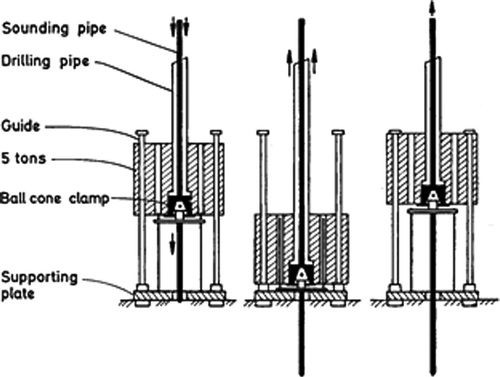
In the mid 1970s McClelland entered the market with their Stingray rig which used a somewhat different approach with the hydraulic ram pushing on the drill string, as shown in (McClelland Citation1975), instead of directly on the CPT rod. also illustrates that the Stingray could be used in connection with drilling, which will be discussed in a later section.
Figure 5. McClelland's Stingray rig (from McClelland Citation1975).

Both the Seacalf and the Stingray had a stroke length of about 1 m, and due to the small stop between each stroke the test could be classified as discontinuous.
In the 1970s, comprehensive soil investigations were carried out in Holland in connection with the Eastern Scheldt Barrier. Delft Soil Mechanics Laboratories (now Deltares) developed a diving bell which could be used as a platform for CPTs and soil borings. It was designed for a maximum 200 m water depth and had a very large reaction force of 600 kN, see Penetrations of more than 60 m below sea floor were reached (Vermeiden Citation1977) in connection with the Eastern Scheldt Barrier soil investigations (in water depth up to 60 m). The diving bell was also used in the Strait of Belles Isle, Newfoundland, Canada.
Figure 6. Diving bell operated by Delft Soil Mechanics Laboratory (from Vermeiden Citation1977).
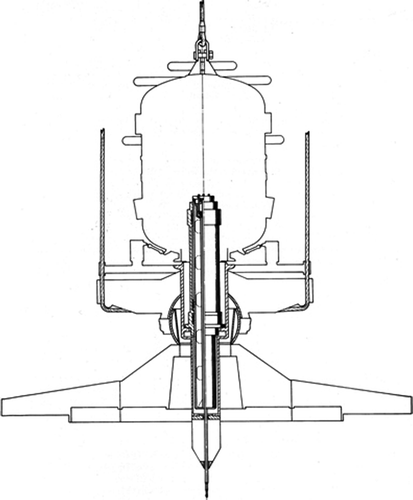
Intensive development at the beginning of the 1980s, resulted in a new generation of CPT seabed rigs that could carry out continuous pushing, giving both increased efficiency and quality. The Dutch manufacturer APvandenBerg was the first to construct a rig using roller wheels to drive the cone rods into the seabottom. This principle had been developed for onshore use many years earlier at the Swedish Geotechnical Institute (Kalstenius Citation1961). APvandenBerg's rig was called the ROSON.
In 1983, the first CPTs using the ROSON system were carried out by the company D'Appolonia at the Oseberg field in the North Sea. An electric motor mounted on the rig drives the wheels and the friction between the wheels and the rods provides the penetration force. Penetration to 17 m in dense sand was achieved. shows a schematic diagram and a picture of the ROSON rig.
In 1984, Fugro started using their wheel drive Seacalf which utilized more or less the same principle as the ROSON.
In 1984, McClelland adopted the Swedish BORROS land 20 ton rig for offshore use, with a continuous push using four hydraulic cylinders operating in two pairs connected to a single automatic rod clamp under each pair. This machine was first operated successfully in an important soil investigation at the Troll field (about 350 m water depth) in the North Sea (Amundsen et al. Citation1985) where 43 m penetration was achieved.
However, after the merger of Fugro and McClelland in 1987, the new company FugroMcClelland concentrated on the wheel drive Seacalf.
Due to the long push rod, a tower or constant-tension winch is needed which can create operational difficulties. In order to allow more efficient operations, and possibly use less costly vessels, the use of a coiled rod was a natural progression. Coiled rods had been first used onshore in the USA for some years before the method found its way to offshore testing.
Mobil Oil in the USA initiated a study of a full size rig through a contract with McClelland Engineers, Houston. The design and construction was carried out through a Norwegian company, Rapp, in Bodø who worked together with FugroMcClelland. This rig, called the TSP, had several interesting features, as described by Power and Geise (Citation1994); see :
Figure 8. Fugro/McClelland's TSP rig (from Power & Geise Citation1994).
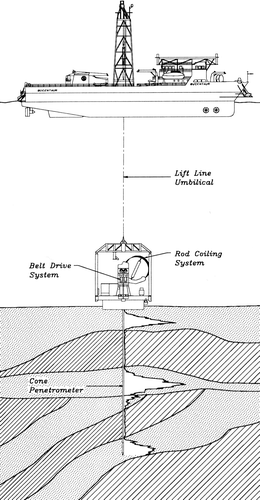
| • | Maximum water depth 3000–3500 m. | ||||
| • | Deployment and control on single lift line umbilical. | ||||
| • | 70 m of 38 mm diameter steel test rod. | ||||
| • | Penetration force provided by a unique “belt drive” mechanism. | ||||
| • | Unfortunately, the TSP rig was only used for a few seabed trials, and never came into commercial operation. | ||||
IFREMER in France (Meunier Citation2000, Meunier et al. Citation2004) designed, built and operates the Penfeld, a full-size seabed coiled rod CPT rig. This rig is rated to a water depth of 6000 m, and can penetrate to a maximum of 30 m below seabed with a thrust of 40 kN. Power is provided by a battery on the rig and control signals use a two-way acoustic link. The push rod is 36 mm in diameter and 8 mm thick. According to Meunier et al. (Citation2004) the rods can be used more than 100 times before they need to be replaced. The straightening and bending modules include four wheels in the same plane. The diameter of the drum with the bent rods is 2.15 m, a length of 30 m corresponds to less than five turns. shows the rig being deployed over the side of the vessel.
The principle of coiled rods is also used on a number of “mini-CPT rigs” using push rods of smaller diameters, as discussed below.
The Portable Remotely Operated Drill (PROD) has been operated by Benthic Geotech, Australia, since 2001 (e.g., Kelleher et al. Citation2008) (). PROD is landed on the seabed, thereafter in situ testing (and sampling tools) are deployed down hole via robotic assembly of the drill string. Borehole depths in excess of 100 m have been achieved using this equipment. The standard CPTU probe with 1 m of 36 mm diameter push rod is attached to a drill string sub and is deployed down-hole in 2.75 m increments until refusal or the target depth has been achieved. The first push from the seabed, before any drilling has taken place, is similar to seabed testing. PROD will be mentioned again in Section 2.3 on down-hole testing.
Figure 10. Benthic's PROD rig (courtesy of Benthic Geotech) (a) PROD on deck (b) Cone penetrometer with pushrod.
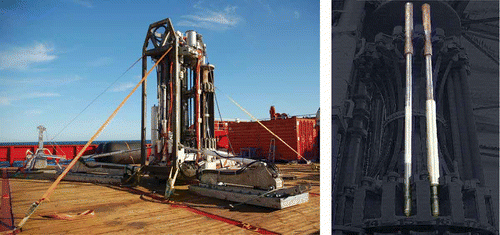
An interesting development has also been to combine CPT with sampling on the same rig during one deployment. Fugro introduced the Searobin in 1997 (Hawkins and Markus Citation1998) specifically for shallow investigations. The combitool allows a 2 m CPT push and a recovery of a 1 m push sample. Geo in Denmark introduced their Geoceptor in 2001, where a 10 m CPT can be combined with up to 6 m vibrocore or push-sampling () (Brinch-Clausen Citation2010).
The use of mini CPT rigs has allowed the use of smaller less expensive ships, and also to have a rig that is easier to transport. Power and Geise (Citation1994) described Fugro's Seascout which uses a coiled rod, which has been used for many years. Another rig is developed and marketed by the UK company DATEM, called the Neptun. The development of the Neptun 3000 started in 1999, and the first offshore use of the rig was in 2000 (Steggar Citation2009). Several versions of Neptun are now used by a range of companies. The Neptun 5000 is rated to a maximum penetration depth of 20 m with a thrust capacity of 35 kN. The push rod diameter is 19 mm and 5 cm2 and 10 cm2 cone penetrometers can be used. shows the Neptun 3000.
Gregg Drilling & Testing in the USA operates mini CPT systems with coiled push rods that have been used in 2,000 m of water, pushes a 2 cm2 cone with a thrust capacity of 15 kN. Gregg also has a new DeepCPT that can push full size cones (10 cm2 and 15 cm2) in up to 3000 m of water with a thrust capacity of 200 kN. The DeepCPT system uses a suction anchor to minimize the submerged weight of the unit (Boggess and Robertson Citation2010).
Small CPT rigs mounted on Remote Operated Vehicles (ROV) have also been used for many years. Geise and Kolk (Citation1983) described the use of Fugro's Mini Wison on a ROV. Due to the fact that the ROV is floating, the penetration capability is limited, but the manoeuvrability allows testing at close proximity to a seabed structure or investigating backfill in a pipeline trench. Other soil investigation companies like Geo and Gardline also operate ROV based CPTrigs.
Seabed rigs developed/planned but not used in practice
Over the years a large number of seabed type rigs have been designed and in some cases a prototype has been built. Some very interesting ideas have been presented, but have unfortunately not found practical applications for some reason or other. Nevertheless, the author believes it is interesting to quickly review a small selection of these documented ideas.
Zuidberg (Citation1972) reported that Shell in Holland designed and built a rig in the beginning of the 1970s. This rig incorporated several interesting features:
| 1. | Reaction force was provided by a suction anchor in addition to the dead weight. | ||||
| 2. | To avoid the rig being too high, the rods were telescopic; when the first standard rod had been fully penetrated, it was further advanced by pushing down together with the first supporting pipe and so on. | ||||
| 3. | To eliminate friction along the tubes of increasing diameter, water was injected under pressure at the bottom of each tube to create and maintain a hole around the sounding rods. Shell had aims of being able to reach 50–60 m penetration with this rig. | ||||
Unfortunately this rig was not used much in practice, but it is interesting that the ideas behind it have come into use in other designs in later years.
The idea of hydrostatic pressure to drive samplers or cone penetrometers into the sea bottom has been around for some time. Two relatively recent patents were obtained by MGS (Marine Geosystems) in France for their Starfish (Bienvenu and Bessonart Citation2001) and the Norwegian TubeCore (Aardal Citation2004). Both were planned to work on the principle of having a chamber at atmospheric or low pressure; when lowering the device to the sea bottom the hydrostatic difference between the chamber and the ambient surrounding water becomes very large. By opening a valve when the rig is at the sea bottom the pressure difference can drive the CPT rods into the sea bottom. Both devices also planned to use the pressure difference to penetrate a suction anchor and to recover the tool afterwards. The main advantage of this type of rig is that a simple mechanical cable can be used and no large batteries are required. The TubeCore was also designed to take a sample in parallel with the CPT to 30 m. However, none of the rigs have yet found any practical application.
The Norwegian engineer and inventor Bjarte Langeland has developed an alternative to coiled rods. The so-called Stinger technology was planned to use a CPT rod split longitudinally in two parts: a rigid pipe comprised of hinged and semi-cylindrical pipe sections that are sequentially joined together to form a rigid pipe. The two halves of the rod can therefore be contained on two drums. The system was planned to be used in conjunction with an ROV using a suction anchor to increase the reaction force capability.
2.3 Penetration in bottom of borehole
The advantage with down-hole CPT in a drilled borehole is that much deeper penetrations can be reached and hard layers can be drilled through. When drilling from the water surface, it is important to have good control on the movement of the drill bit by having an efficient heave compensation system to minimize disturbance in the soil, such as the hard-tie system developed by Fugro (Zuidberg et al. Citation1986).
In parallel with the development of the Seacalf, Fugro also designed a wireline CPT tool that could be used in connection with drilling. The system was called the WISON, with the prototype available in 1970 as presented by Zuidberg (Citation1972); the principle is shown in In the beginning, the stroke was limited to 1.5 m, which was later extended to 3 m. An umbilical provides mechanical connection, electrical cables for data acquisition in real time and hydraulic power for penetration. The device is locked into the drill string, the weight of which provides reaction force. APvandenBerg developed a similar device that is called WISON-APB that became operational in 1973/4 as described by Berg (Citation1984).
Figure 13. Fugro's Wison (after Zuidberg Citation1972).
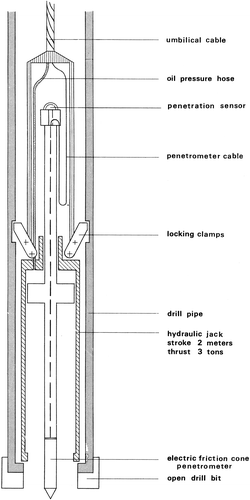
McClelland followed in 1974 with their Stingray system which used a different approach to push the cone penetrometer (McClelland Citation1975). The WISON has the driving force inside the drill string in terms of a hydraulic cylinder. For the Stingray, the drill bit was hoisted above seabed as shown in , then the cone penetrometer was lowered inside and locked. The pushing was then done by a hydraulic ram cylinder gripping on the outside of the drill string. The total penetration for each cone deployment could be 4.5 m (15 ft) by repeated strokes of 0.3--1 m (1--3 ft). Later McClelland developed a system called the Swordfish which used a similar system as the WISON with a hydraulic cylinder inside the drill string (Meyer et al. Citation1982). The Swordfish had a penetration capacity of 3 m (10 ft) below the drill bit and was mainly used in the Gulf of Mexico.
Due to the need for an umbilical with hydraulic oil, the depth limitation of the systems described above is about 600--700 m (water depth plus depth below seafloor). To allow deeper testing, McClelland developed the Dolphin system in 1984 (Peterson and Johnson Citation1985) which is a remote tool without umbilical. The sampling or in situ tools were allowed to free fall within the drill string and after the test to be retrieved on a wireline using an overshot. The tools latch in a bottom-hole-assembly located immediately above an open centre drill bit. The drill string is closed at the top and mud pressure is used to push the in situ tools into the soil below the drill bit. A control system ensures a constant rate of penetration of about 2 cm/s. Each stroke could be 3 m. Upon retrieval the data stored in a memory unit is downloaded to a computer and the results can be processed. shows the principles of the Dolphin system. Maximum thrust is about 110 kN.
Figure 14. McClelland's Dolphin system (Peterson & Johnson Citation1985).
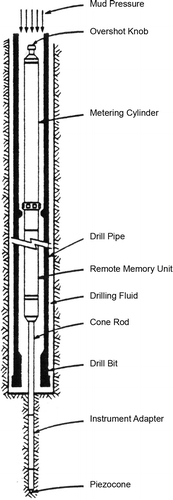
In the early 1990s, Fugro developed a similar system called the WISON-XP; this has a stroke of 1.5 m (Power and Geise Citation1994). A limitation with the Dolphin and XP systems is that results are not available in real time. Peuchen and Raap (Citation2007) report on Fugro's WISON-EP system which uses mud pressure combined with real time data presentation. The initial version had a down-hole stroke of 4.5 m; the current version has a 3 m stroke.
At the time of preparation of this paper (March 2010) there is only one remotely-operated seabed drill rig that has been used on several occasions for commercial soil investigation projects: the PROD operated by Benthic, Australia (Pennington and Kelleher Citation2007). As described in the previous section, this rig can be used for seabed penetration to refusal, or to a pre-determined depth. It can also be used for deeper penetration by penetrating below the drill bit in a drilled borehole. Since the cone penetrometer is pushed in with the drill rods, it is possible to push much deeper than the WISON type tools described above. In favourable soil conditions it is possible to do the first penetration from seabed to for example 20---30 m, then drill out to the depth of the previous stroke and then push for example another 15--20 m before drilling again. In deep water the PROD, and other seabed drilling machines, are considerably more efficient than ship based drilling systems due to less handling of drill string for the seabed based systems. Another advantage of seabed drilling systems is that the zeroing of the cone sensors can be done accurately at a fixed depth (e.g., 0.7 m for PROD) just above the seafloor. This gives less uncertainty compared to the Wison type methods, which have to take zero readings on deck level or at the bottom of the borehole.
Gregg in the USA is building a remotely controlled seabed drill rig that will operate in up to 3000 m of water and can obtain soil or rock samples using wire-line rotary and push sampling as well as wireline CPT. The new seabed rig is expected to be operational in late 2010 (Boggess and Robertson Citation2010).
The Italian company SPG and the Swedish company ENVI have together developed an alternative method for performing CPTs in a borehole, as illustrated in , the CPTWD. A cone penetrometer protrudes in front of the drill bit during drilling in the same way as a core barrel. CPT data are stored in a memory unit (Memocone). At the same time as CPT data are logged, drilling parameters (drill bit load, torque, rate of penetration and fluid pressure) are recorded in real time. If a hard layer is encountered, the CPT unit will be pushed into the drill bit and protected; the CPTU unit can also be retrieved using a wireline allowing cores to be taken. Another potential is that combination of both CPT and drilling parameters will be a powerful basis for interpretation of the data. The advantage of this system compared to the down-hole type CPT described above is that much longer strokes than the normal 3 m can be made. Information from the drilling parameters will be very useful, especially in hard formations where the CPT cannot be performed. So far the CPTWD has only been used in shallow water from a fixed platform. Further studies are needed before this new method can be used in deeper waters, but it is very promising (Sachetto Citation2010).
Figure 15. CPT while drilling, CPTWD (after Sachetto Citation2004) (a) principle (b) Picture.
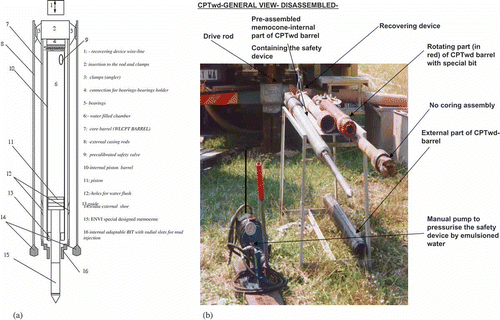
below summarizes the development of down-hole systems described above.
Table 1. Summary of the main developments for seabed rigs
Table 2. Summary of the main developments of down-hole type CPTs
3. Cone penetrometers
3.1 Introduction
This section will cover the basic CPT tool in some detail. Modifications to the CPT and add on devices that measure additional parameters to the CPT data will also be discussed. In most cases, the evolution of cone penetrometers has resulted from onshore projects. But as will be clear from the following there are also cases where offshore requirements have triggered significant probe developments.
3.2 Basic CPT
With reference to and the first cone penetrometer to be used offshore was the 10 cm2 Fugro friction cone (de Ruiter Citation1971). This measured cone resistance, qc, and sleeve friction, fs. The tests done by NGI and McClelland at Ekofisk in 1972 were carried out with a vibrating wire 10 cm2 cone penetrometer developed at NGI, but this was not used further offshore after these tests. Following research with pore pressure measurements in Norway (Janbu and Senneset Citation1974), USA (Schmertmann Citation1974 and Wissa et al. Citation1975) and Sweden (Torstensson Citation1975), the piezocone (or CPTU) with measurements of qc, fs and pore pressure, u, was gradually developed by Fugro and other organizations. In 1981, Fugro first used a CPTU offshore (de Ruiter Citation1982). Up to 1985 most CPTUs were carried out with the filter on the face of the cone (u1); see (from Zuidberg et al. Citation1982). From 1985 most tests have been carried out with the filter in the present u2 (shoulder) position.
Figure 16. Fugro's 15 cm2 piezocone with pore pressure on cone face (after Zuidberg et al. Citation1982).
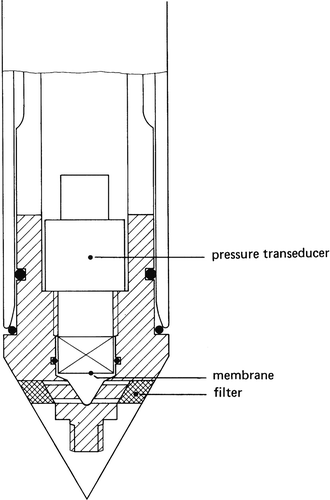
Fugro's initial piezocone had the standard 10 cm2 area and was used both in the seabed and down-hole mode. But they soon started a practice that has been continued with a 10 cm2 cone for down-hole tests and a 15 cm2 cone for seabed mode testing. The 15 cm2 cone has an area ratio, a = 0.59, while the 10 cm2 cone has a = 0.75. This means that if two tests with the 15 cm2 and the 10 cm2 cones are carried out beside each other in soft clay the measured cone resistances will be significantly different. It is therefore essential to correct cone resistance for pore pressure effects (e.g., Campanella et al. Citation1982). Most other cone types used offshore have an area ratio around 0.75, and it is a requirement to always correct cone resistance for pore pressure effects. For deep seabed CPTs, measurements of inclination have been included since the 1970s.
In connection with CPTs from mini seabed rigs, smaller cones are also used, such as 1 cm2, 2 cm2 and 5 cm2. However, Fugro has also used a larger cone with an area of 33 cm2. The planned European standard EN ISO 22476-1: (E) (to be ISO standard) allows cones to have diameters in the range 25 mm (area = 4.9 cm2) to 50 mm (area = 19.6 cm2). For tests using cone diameters outside this range, the report with the CPT results should mention that the test does not adhere to the standard.
In deep water a problem with the CPT is the fact that the sensors start with a large force at the seabed due to the hydrostatic pressure. For instance in 2000 m of water the pore pressure sensor will measure 20 MPa and the measured cone resistance will be 15 MPa (with an area ratio, a = 0.75). For very soft clay, the cone resistance at 10 m depth with reference to the seabed will be, about 350 kPa, and it is desirable to have a measurement accuracy of ±35 kPa; i.e. a very small value compared to the starting value. For many years it has been recognized that measuring differential pressures or resistances should significantly increase the accuracy of the measurements. Over the years there have been many attempts to develop cone penetrometers that can measure differential cone resistance and pore pressure, but apparently none of them were successful. However, IFREMER (France) now operates a cone penetrometer that can measure differential cone resistance and pore pressure (Meunier et al. Citation2004and Sultan et al. Citation2007). Also, a new cone design has been developed and patented by Gregg Drilling and Testing Inc. USA, that is based on a hydrostatically compensated cone using specially designed load cells. The load cell records the load that is independent of hydrostatic pressure by filling the inside of the cone with oil and connecting the inner oil with the seawater outside the cone. The specially designed load cell (Boggess and Robertson Citation2010) acts as a shear load cell that is not influenced by hydrostatic confining pressure; see schematic in The load cell is tubular with offset slots (250) to measure the axial load in shear (280) using strain gauges (310) (numbers in relate to the full patent description).
Figure 17. Compensated shear load cell design (from Bogess & Robertson Citation2010).
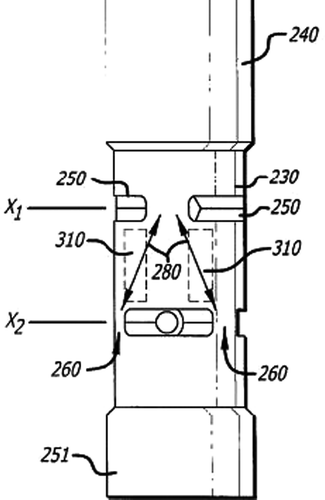
The Dutch manufacturer APvandenBerg is also developing a compensated cone that is expected to be marketed in 2010 (Storteboom Citation2010). The use of hydrostatically compensated cones should lead to more accurate results and the author hopes such cones will find extensive use offshore in the future.
The offshore soil investigation industry generally uses a rather limited number of different cone types, and all adhere to the EN-ISO Standard as regards to geometry and size. In order to find out if cones used by different organizations give similar results, a series of tests were performed at NGIs soft clay test site in Onsøy, about 100 km south of Oslo, with a number of cone penetrometers, including at least four that are typically used offshore. The Onsøy site is very uniform both with depth and laterally, and is ideal for such studies (Lunne et al. Citation2003). The tests showed that there are no significant differences in the corrected cone resistance (qt) and the pore pressure (u2) as long as the cones are properly saturated. However, the measured sleeve friction varied significantly as shown in , where typical results of CPTs carried out using cones operated in offshore soil investigations are included.
The problems of variations in fs experienced in offshore projects can also be seen from the two examples included in
As shown by Lunne et al. (Citation1986) and Boggess and Robertson (Citation2010), an important factor in the differences in fs values, can be explained by the fact that some cones have different end areas where pore pressure can act at the top and bottom of the sleeve, as shown in
Lunne et al. (Citation1986) and Boggess and Robertson (Citation2010) argued that one way to reduce the differences in fs readings, at least in soft clays, is to use friction sleeve with equal end areas, and indeed the ASTM (D 5778-2007) standard has this as a requirement. But there must also be some other effects since tests in sand have also shown large differences in fs values (e.g., Lunne et al. Citation1986, Tiggelmann and Beukema Citation2008). The author believes that for offshore applications, with the present large variations in fs values, it is not possible to utilize this measurement to its full potential in terms of interpretation of results, as for instance advocated by Robertson (Citation2009). It is therefore a significant challenge for the future to try and better understand the reasons for the large variations in the fs readings, and to develop specifications that lead to more uniform practice. It is important that companies manufacturing cone penetrometers as well as research organizations and soil investigation contractors co-operate on this issue.
3.3 Triple element CPT
In connection with the pioneering Gullfaks C gravity base platform in the North Sea, Statoil commissioned McClelland in 1986 to develop three special cone penetrometers (Bayne and Tjelta Citation1987):
| • | A 15 cm2 triple element CPT with filters on the face of the cone, just behind the cone and above the friction sleeve (see ). The main purpose of this cone was to be able to correct the sleeve for pore pressure effects. Figure 21. McClelland's triple element piezocone and special cones (from Bayne & Tjelta Citation1987).  | ||||
| • | A 15 cm2 cone penetrometer with a sleeve module with total pressure and pore pressure that could be moved at various distances behind the cone tip. | ||||
| • | A 40 cm2 cone penetrometer with pore pressure sensor and the possibility to apply positive pore pressure through the tip in order to counteract negative pore pressures and to study effects on penetration resistance in various soils. A secondary purpose was to study scale effects. | ||||
These cone penetrometers were successfully used at the Gullfaks C location, with an example result included in
Figure 22. Results of triple element piezocone from Gullfaks C (from Bayne & Tjelta Citation1987).
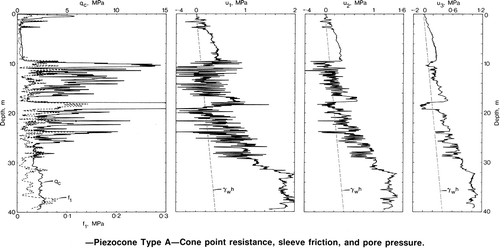
The triple element cone was continued to be used for many soil investigations, the other cone penetrometers were to the author's knowledge only used for the Gullfaks C investigation. Fugro also developed a triple element cone penetrometer in 1986/7 (Zuidberg Citation1988). Both Fugro's and McClelland's triple element cones were used for some years in the Norwegian sector of the North Sea, but very seldom in the last 10 years.
3.4 Other sensors included in cone penetrometers
With improved data acquisition systems and intensive research by several organizations in the 1980s, a number of developments were made with adding sensors to the main CPT tool. summarizes a number of devices that were used. The lateral stress cone was an attempt to measure the in situ lateral stress by instrumenting the friction sleeve, and was used in the Beaufort Sea (Jefferies et al. Citation1987). However, research at several universities in Europe and North America did not conclude that lateral stress could be reliably interpreted from the results and this device was only used a few times. The cone pressuremeter was also developed to measure in situ lateral stress and deformation moduli. Considerable research has been performed relating to this device, both in the UK and the Netherlands, and several authors claim excellent potential for this device, both in sand and clay (e.g., Withers et al. Citation1986). However, the cone pressuremeter has so far found very limited application offshore.
Table 3. Some CPTU add on devices that have been used offshore
The electrical resistivity probe was introduced in the Netherlands with the aim of measuring in situ density (Kroezen Citation1981). The electrical resistivity of the soil volume was measured in addition to the standard CPT parameters. The resistivity of the pore water must also be measured using a separate probe or by measuring on obtained samples. The field measurements may then be correlated to density based on laboratory calibration to specimens reconstituted to different representative porosities or densities. The device has also been used for assessment of contamination in situ on some offshore projects.
Delft Soil Mechanics Laboratories (DSML)(now Deltares), the Netherlands, developed a nuclear density probe that was used on a project in the North Sea (Tjelta et al. Citation1985). This device had a radioactive source and detector built into a 15 cm2 cone. The bulk density was determined by measuring the energy levels of the photons emitted from the source and of the photons entering the detector after radiation of the soil mass. The equipment was calibrated by lowering the probe into fluids with known unit weights between 10--22 kN/m3. shows the results of a test carried out at the Gullfaks C field in the North Sea. As mentioned by Lunne et al. (Citation1997) other probes have been developed using this principle including work at Kyoto University (Mimura et al. Citation1995). As will be discussed in more detail in Section 6, the author believes that for intermediate soils like sandy silt and/or sands with high compressibility, this device has a great potential for more application than currently shown.
Figure 23. Combined results of piezocone test and nuclear density test at Gullfaks C in the North Sea (from Tjelta et al. Citation1985).
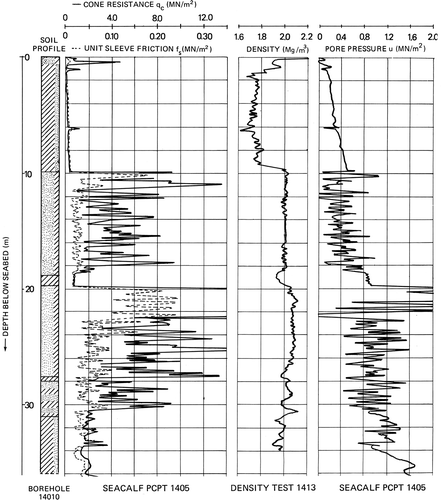
The modern version of the seismic cone was developed at the University of British Columbia (UBC) and its use offshore was reported by Campanella et al. (Citation1986). shows a typical set up for seabed testing as described by Peuchen et al. (Citation2002). The seismic cone (SCPT) can be used in both down-hole and seabed mode testing. In favourable soil conditions, penetrations up to 90--100 m below seabed can be achieved; one example is shown in Normally travel times are recorded at different depth intervals so that the average shear wave velocities (Vs) can be computed over each depth interval. The small strain shear modulus can be computed in these intervals using elastic theory: Gmax = Vs 2 ρ where ρ is the soil mass density.
Figure 24. Schematic layout for seabed seismic cone testing (from Peuchen et al. Citation2002).
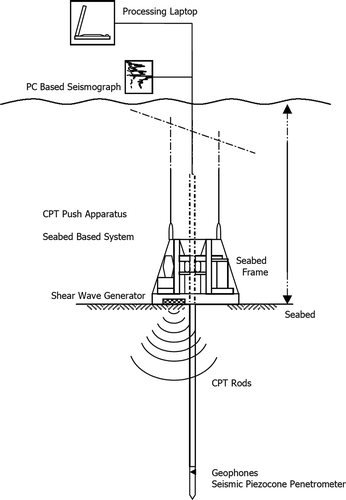
Figure 25. Results of Gmax measurement (from Lange et al. Citation1990).
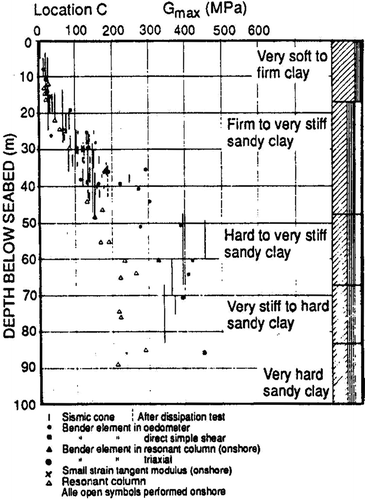
When coupled with the CPT, the seismic cone is a very powerful tool. The test was used quite a lot for a 10–15 year period, but far less during the last 10 years or so. The author agrees with Mayne (Citation2000, 2006) and others that the SCPT is under-used and that it is a future challenge to include SCPT more frequently in important soil investigations. This will be elaborated in Section 6.
More recently than the devices mentioned above are the so-called full flow penetrometers: the T-bar and the Ball probe. A significant amount of research has been carried out on these devices, mainly in Australia (e.g., Randolph et al. Citation1998, Citation2007, Low et al. Citation2010). There are two main advantages of these tests:
| 1. | The cross-sectional area for the “standard” version of both tools is 100 cm2, i.e. 10 times larger than the 10 cm2 cone. The ball thus has a diameter of 113 mm and the T-bar has a diameter of 25 mm and a length of 40 mm. | ||||
| 2. | Since the soil can flow around the tool it is not necessary to subtract the full overburden stress when deriving the undrained shear strength. | ||||
Frequently the ball or T-bar resistance is measured by the same load cell as the cone by unscrewing the tip of the cone and screwing on the T-bar or ball instead, as shown in Thus it is relatively easy to accommodate T-bar or ball tests in seabed mode. Due to the size of the API drill string used in down-hole mode, the tools cannot be used in their full sizes. In practice, only balls with a reduced diameter (60--78 mm) are used in down-hole mode (e.g., Kelleher and Randolph Citation2005, Peuchen et al. Citation2005). By cycling the ball or T-bar up and down several times, it is possible to investigate the remoulded shear strength in situ. Some comments on interpretation of the full flow tests are given in Section 6.
Other penetration devices that are not incorporated directly with the CPT tool but can be pushed together with the CPT include, but are not limited to: piezoprobe, heat flow probe, and dilatometer. These are not discussed here, but an overview is given by Lunne (Citation2001).
4. Data acquisition and processing
It is outside the scope of this paper to go extensively into the technical details regarding data acquisition and the tremendous developments that have taken place. For the first offshore geotechnical surveys in the beginning of the 1970s measurement data was transmitted through an electrical cable and recorded on a chart recorder. Onboard plotting of CPT profiles and soil boring profiles was done by hand; thus the client had to wait for some hours before the results could be presented. Reporting to the onshore base was done by telex communication or by voice conversations over radio. Final checking of data and plotting of results in engineering units was done in the office after demobilization.
Nowadays several options are available for data acquisition onboard:
| • | Electrical signal transfer through a cable. | ||||
| • | Acoustic transmission through the water column. | ||||
| • | Storing data in memory unit in the CPT tool and unloading and processing data when the tool is recovered on deck. | ||||
One interesting example of modern technology is used by the sea bottom based drill rig PROD. In this case the CPT data (qc, fs, u) are transmitted acoustically up the drill string to a microphone installed on the PROD, using the Swedish Geotech system. Data is then transmitted to the vessel through a fibre optic cable.
The data are now available immediately after the test, but they should be subjected to a quality control before given in preliminary form to the client on board. The results can be further processed so that both measured and derived parameters can be plotted and sent to onshore based offices within minutes. Soil boring profiles integrating both results of CPT and field laboratory tests can be produced on a continuous basis.
5. Standards and guidelines
Currently, the only standard specifically prepared for offshore in situ testing is the NORSOK G-001 (Citation2004) Standard that was initially prepared for projects offshore Norway; but has completely or partly also been used in other parts of the world. The NORSOK was gradually developed since 1983 when the offshore soil investigation industry in the North Sea joined to have yearly meetings in the so-called Offshore Soil Investigation Forum (OSIF). In the mid 1980s, an OSIF-appointed committee prepared the first specifications for in situ testing, sampling and laboratory testing used by the operators in the North Sea. These specifications gradually developed into the first version of the NORSOK standard in 1996; this was later updated in 2004. The NORSOK standard was consistent with the International Reference Test Procedure (IRTP) for the CPT that was issued by the International Society of Soil Mechanics and Geotechnical Engineering in 1977, 1989 and 1999, and the EN ISO 22476-1:(E) (Citation2007).
In parallel with the NORSOK Standard, the major international oil companies have had their own specifications, frequently using the NORSOK Standard as their basis. The use of NORSOK and other related documents has been very important for ensuring consistent requirements for equipment, procedures and reporting.
In May 2007, an initiative was taken to form a committee with the aim of developing an ISO Standard for Marine Soil Investigation, using the NORSOK standard as one of the main references. The committee consists of 33 members from 13 countries, and as per January 2010 a complete Draft was prepared. The final document is planned to be published in 2014.
There are many important aspects of the new ISO standard regarding the CPT. This paper only discusses the issues of recording and reporting reference readings before and after a test. NGI receives results of CPTs performed in many parts of the world, by many different operators. In the last few years, the problem of incorrect reference readings in down-hole testing has frequently been observed. Figure 27a illustrates one such case where the contractor took zero readings in the bottom of the borehole without checking with the deck readings.
When NGI requested readings at deck level, and at the bottom of the borehole, it was evident that the cone had touched a soil plug inside the drill string and hence an excessive offset value was subtracted from the initial reading in the bottom of the borehole. The use of reference readings at deck level would have avoided this problem.
Using the reference readings at deck, the correct zero load at the bottom of the borehole could be calculated and the results corrected to give a more representative profile as presented in . The new ISO standard will require that reference readings at deck level shall be standard practice for down-hole testing with vessel based drilling. This example also illustrates the importance of quality control of the data, since such mistakes should not be difficult to detect by a qualified operator.
One way to have better control of the data from deployment at deck level and until recovery back on deck is to record and present a continuous record of the measured parameters. The new ISO standard also recommends that this is done. is taken from the new ISO standard and shows in principle how the deck to deck readings should be presented for a seabed CPT. Note that all readings are plotted as a function of time. A similar recommendation is given for down-hole testing. The ISO standard includes recommended actions if the reference values after a test deviate from those before the test.
Figure 28. Recommended scheme for reporting deck to deck readings for seabed CPTUs in new ISO standard.
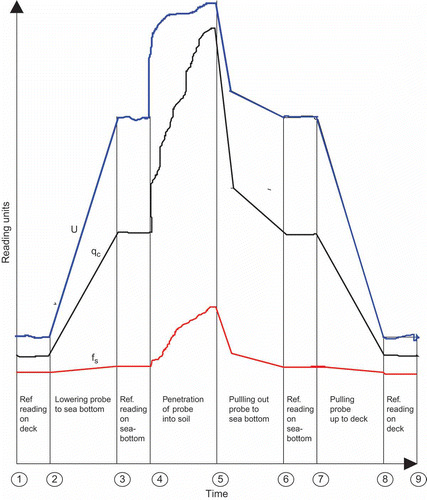
As mentioned earlier in this paper, the problem of reference readings relative to seabed for down-hole tests are largely reduced for seabottom based drill rigs since the reference readings can be taken at a fixed distance (e.g., 0.7 m for the PROD rig) above seabed.
A challenge for the future is that all offshore operators follow the new ISO standard and carry out the required quality control of the data, including calibration, etc. Of course, the contractor performing the test has the main responsibility for data quality. But due to tough competition and lack of time, short cuts are sometimes taken. It is very important that the client therefore fully integrates the ISO requirements into the tender documents and that they follow up during all phases of the work. When the new ISO standard is completed, the committee plans to make a significant effort to make all parties involved in offshore soil investigations aware of the requirements and recommendations given in the document, and to have contractors implement quality control schemes to avoid mistakes as shown in
6. Interpretation
6.1 Profiling and soil design parameters
A large number of R&D studies have been carried out in many parts of the world with the aim of improving the interpretation of CPT data in terms of soil parameters for offshore applications. Numerous papers have been published based on these studies covering a wide range of soil parameters and applications, and most of them are valid for onshore as well as offshore practice. It is not possible to review all these parameters and applications herein, and only a few examples are included in the following.
6.1.1 Profiling and soil identification
It is generally accepted that the CPT is the best tool for defining soil layering across a site. In some cases the cone resistance and sleeve friction may be sufficient for this purpose, but the addition of penetration pore pressure is also very useful. All three measured parameters should be used in addition to derived parameters. The most common derived parameters are the friction ratio, Rf = qt/fs 100 %, and the pore pressure ratio, Bq = (u2 – uo)/(qt – σvo).
Figure 29 shows an example from a windfarm site just off the UK coast. In this case, both the measured parameters qt and u2, as well as the derived parameters Rf and Bq clearly show the various layers. In this case, the soil types are also quite well defined from the Soil Behaviour Type chart (Robertson Citation1990).
There are many cases where the soil types are not as well defined as the case in , and the use of additional measurements can be very beneficial. As an example showed the in situ soil density as evaluated with the nuclear density probe together with the usual CPT parameters.
Several authors have recommended using the seismic cone for enhanced soil type definition; for instance Schnaid (Citation2009) for differentiating cemented sands from uncemented sands.
6.1.2 Undrained shear strength of soft clay
When the CPT first started to be used in the North Sea, there was little experience with interpretation of the results in terms of the undrained shear strength of clays. During a meeting, NGI's Chief Engineer Ove Eide and Fugro's Director Jaap de Ruiter, agreed to improve this situation and in 1973 the author was sent with two Fugro operators in a truck to perform a series of CPTs at well documented sites in Norway and Denmark as shown in . The test sites were supplemented with the Skå Edeby site during the first ESOPT conference in Sweden in 1974.
The reference undrained shear strength for these sites was the vane strength, su,vane, and the results of the study were published in 1976, with a key plot included here as The data reveal an approximate correlation of the cone factor Nk = (qc – σvo)/su,vane with plasticity index, Ip. Variation in Nk was from 8 to 24. For typical North Sea clays with plasticity in the range 20–30%, Nk was in the range 15–20. At that time pore pressure was not measured so qt could not be used. It was also known that the vane shear strength should be corrected for anisotropy and rate effects before being applied for stability calculations (e.g., Bjerrum Citation1973). This meant there were several uncertainties with the factors shown in , but the range 15--20 was frequently used to obtain an average undrained shear strength.
Figure 30. Clay sites investigated by NGI and Fugro (Lunne et al. Citation1976).
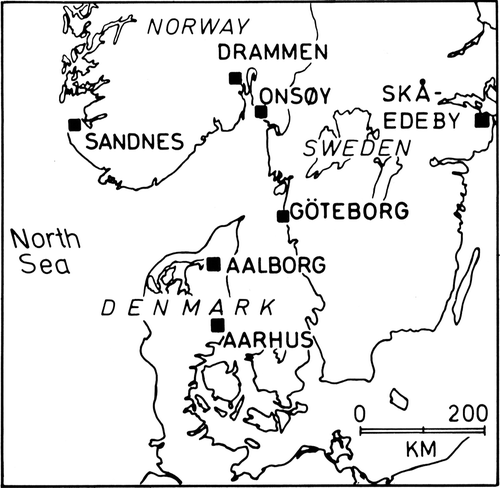
Figure 31. Cone factors based on vane shear strength (Lunne et al. Citation1976).

Many studies have subsequently been carried out (e.g., summary in Lunne et al. Citation1997 and Karlsrud et al. Citation2005) with higher quality CPTU data and based on a reference undrained shear strength from triaxial tests sheared in compression. The triaxial tests were carried out on high quality samples which were consolidated to the best estimate of in situ stresses, i.e. CAUC tests. With increasing quality of results, the Nkt factor has gradually decreased, frequently to the range 10–13, with su from CAUC triaxial tests as the reference strength. A recent joint study carried out by NGI and COFS (Centre for Offshore Foundation Systems, Australia) established a high quality data-base including results from CPTU, T-bar and ball tests, as well as CAUC tests on high quality samples (su c). The data base included field and laboratory data from 11 offshore and three onshore soft clay sites (Low et al. Citation2010). This study revealed a tendency for the cone factor Nkt = (qt - σvo)/ su c and especially pore pressure factor (NΔu = (u2 – u0)/su where u0 = in situ static pore pressure) to vary with rigidity index (Ir = G/su); however this was not the case for the T-bar and the ball. Nevertheless the total variation of NT-bar was not less than the variation in Nkt. NΔu showed a larger variation. summarizes the results in terms of recommended N-factors based on su c. For the ranges given in , the lower values should be used to compute su c when it is conservative to use a high strength and the higher value should be used when it is conservative to use a low shear strength. These N-factors should only be used for clays with sensitivity less than eight and should be updated with local correlations whenever possible. shows the largest variation for NΔu and it is not advised to use this N-value at new sites with no previous experience. However, when NΔu can be determined locally, such as in Norway (e.g., Karlsrud et al. Citation2005), NGI has found it beneficial to compute su using both Nkt and NΔu. It is useful to recall that NΔu = Nkt · Bq. includes one offshore example. For completeness it should be mentioned that the NGI/COFS study also recommended NT-bar-values for remoulded shear strength, noting that the values vary according to how the reference remoulded shear strength is measured as is the case for intact su. More details of this study can be found in Low et al. (Citation2010).
Figure 32. Deepwater example with undrained shear strength interpreted from CPTU and CAUC triaxial tests.
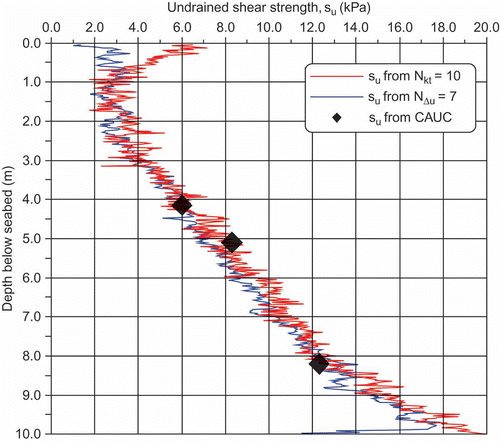
Table 4. Recommended N-factors (adopted from Low et al. Citation2010)
For very soft clay sites in deep water, it can be very useful to obtain T-bar or ball probe test data in addition to CPTU. However, the introduction of potentially more reliable compensated cones should improve confidence in CPT-based interpretation at such sites.
6.1.3 In situ density of sandy soils
Even though Sanglerat (Citation1972) published a lot of information on the use of CPT for pile bearing capacity in sands in his comprehensive book on the CPT, little guidance was available for interpretation in terms of in situ density. When McClelland and NGI became involved with the Ekofisk tank, which was founded on very dense sands, it was convenient that Prof. John Schmertmann at University of Florida started a comprehensive research program with CPTs in sands using a large (1.2 m high, 1.2 m diameter) calibration chamber. Based on his first calibration chamber (CC) tests and good quality field tests, Prof. Schmertmann, in a letter to McClelland dated 7 October 1971, included the first chart for estimating relative density, Dr, from measured cone resistance, qc, and in situ vertical effective stress, σvo' (see ).
In his letter Prof. Schmertmann stated: “Direct use of the chart requires that the sand consists primarily of quartz, it has no significant impurities such as mica or shells, that it falls within the size range between silty fine sand to uniform sand, and that the sand is normally consolidated. Only use cone bearing values below 2 ft. from the surface. The chart represents conditions for sands that are known to be not cemented (as in the lab chamber tests)”.
The chart in and Prof. Schmertmann's work formed the basis for subsequent research in large calibration chambers, such as at NGI in the period 1975–1978 (e.g., Parkin and Lunne Citation1982). But the most significant effort was the work in Italy under the direction of Prof. Jamiolkowski. Over a period of about 20 years, a large number of high quality CC tests on Norwegian Hokksund and Italian Ticino sands were carried out. This work resulted in charts for deriving Dr for both normally consolidated and overconsolidated sands (e.g., Baldi et al. Citation1986). To go back to the work related to the Ekofisk tank in the North Sea, the approach adopted by NGI was to use the measured cone resistance and assess the relative density, Dr, from the diagram shown in The samples were then reconstituted in the laboratory to the density estimated from the CPT, consolidated to estimated in situ stresses, and subjected to static and cyclic loading in triaxial and DSS tests. This approach is still used today. Correlations directly between CPT parameters and strength and deformation parameters are also used (e.g., Lunne et al. Citation1997, Robertson Citation2009) as an alternative or complement to laboratory testing.
The limitations given in Schmertmann's quote above relating to the chart in are however still valid. There seems to be an increasing trend in offshore projects for sandy soils to deviate the sand types used in the CC tests, for instance sands may have from higher silt contents or different mineralogies. At present there is no consistent methodology for interpreting relative density for these different types of soils. Attempts have been made to use corrections for sand with high silt content and for sands with high compressibility, such as carbonate soils, but in the author's opinion they are associated with high uncertainties. It is also highly questionable whether the relative density concept is in fact valid for sands with higher silt content, say 20–35%. shows a case with a silty sand/sandy silt below a pure sand from the soil profile shown in The solid line shows the relative density interpreted using the Baldi et al. (Citation1986) correlation based on qc and σvo', indicating very low values (Dr = 20–50%) in the silty sand/sandy silt layer. The dotted line shows an updated relative density profile based on a correction for silt content which was originally intended for liquefaction analyses as shown in In qc1 = (qc/pa)(pa/σvo')0.5. This correction includes some uncertainty and is not generally recommended, but it is used here to illustrate that the correlations for sands with high silt content based on qc and σvo' can significantly underpredict the in situ density. Direct measurements on samples seem to confirm the corrected Dr values, but these measurements are also uncertain since it is not known how much the sampling process affects the density of the silty sand/sandy silt.
Figure 33. Schmertmann's original qc, σvo', Dr chart (from Schmertmann Citation1971).
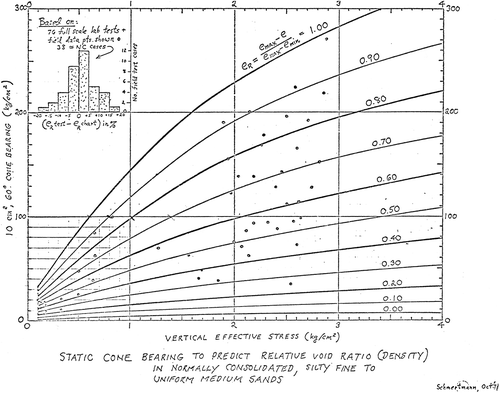
Figure 35. Correction of fine content for liquefaction analyses (adapted from Seed and de Alba Citation1986 and Stark and Olson Citation1995).
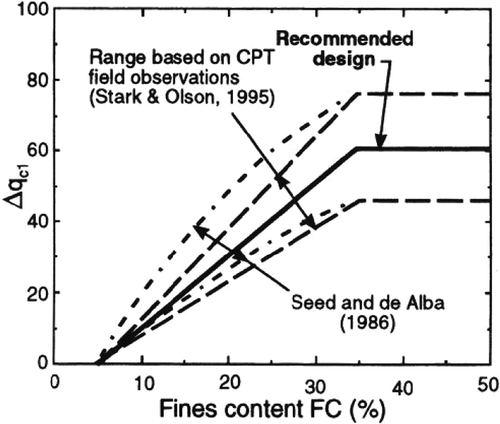
There are similarly large uncertainties related to very compressible sands, e.g., Mayne (Citation2006).
There is a pressing need to improve the interpretation of CPT data in highly silty and/or compressible sands. Suggested improvements that should be evaluated more closely include, but are not necessarily limited to:
| 1. | Measure shear wave velocity in the field using seismic cone; carry out laboratory tests reconstituted to different densities and consolidation stresses and establish correlations between Vs, consolidation stress and density. | ||||
| 2. | Use the nuclear density probe and measure in situ density directly (e.g., like in ). | ||||
| 3. | Use the more fundamental state parameter approach as originally suggested by Been and Jefferies (Citation1985), which has now been put into greater perspective by Jefferies and Been (Citation2006). Robertson (Citation2010) also suggest that the state parameter approach should be preferred to the use of Dr. | ||||
| 4. | Carry out more calibration chamber tests on a wider range of sands. | ||||
6.2 Use of results for direct design application
From the beginning, offshore CPT data have been applied directly to pile bearing capacity analyses. Several methods were summarized by Sanglerat (Citation1972), especially for sandy soils. A large number of refinements for offshore applications have been published over the years; e.g., de Ruiter and Beeringen (Citation1979). The latest version of the API (Citation2007) code now recognizes that CPT based methods are more reliable for sands than the traditional API approach, where the latter assumes that both unit side friction, τf, and unit tip resistance, qb, vary in proportion to the free field vertical effective stress (σvo'). But the imposed limiting values of τf and qb generally control the capacity of long piles. API recommends four recent CPT-based methods:
| • | Simplified ICP-05. | ||||
| • | Offshore UWA. | ||||
| • | Fugro-05. | ||||
| • | NGI-05. | ||||
These methods are described and evaluated against a sand database by Schneider et al. (Citation2008) confirming that they give better predictions than the original API method.
The use of large gravity based structures following the Ekofisk tank (installed in 1973) included skirts below the foundation base in order to transfer horizontal forces to stronger layers, to act as compartments for underbase grouting and, if necessary to allow use of suction to increase penetration force. The penetration of such skirts has been an important aspect of foundation design, and the CPT is of course an ideal test for this. Since the platforms were instrumented, it was possible to compare the observed penetration resistance with the cone resistance and to develop empirical factors for short skirts (e.g., Lunne and St. John Citation1979). Skirt penetration is also an important issue for suction anchors used for floating structures, and empirical CPT-based prediction methods have been developed, although there is a fairly wide range in the empirical factors (Andersen et al. Citation2008 and Aas and Saue Citation2009).
7. Summary and conclusions
The CPT has been an essential part of offshore soil investigations since the beginning, about 40 years ago. The CPT is the best tool to determine stratigraphy across a site and the test also provides significant input to the determination of soil parameters for foundation design and for the evaluation of geohazards.
Impressive developments have taken place in terms of CPT deployment systems and there are now many different ways to execute the tests in a range of water depths, from nearshore to more than 3000 m. The cone penetrometers themselves are now largely standardized and the CPT is used worldwide as a reference in-situ test. Add on sensors are available that can greatly enhance the interpretation of soil parameters.
Data acquisition has become very efficient, with results processed immediately after the test offshore and then transmitted to onshore locations for quality assurance and even design within minutes.
Different equations and empirical correlations are available for reliable interpretation of test results for a large range of soil parameters in pure sands and clays.
API recognizes that CPT based methods give more reliable predictions of pile bearing capacities in sands compared to the ‘traditional’ API approach.
However, there are still many future challenges with the test and its application. The author hopes that development in the site investigation industry over the next decade will include, but not be limited to, the following:
| 1. | More widespread use of seabed-based drilling for deep water investigations. | ||||
| 2. | General improvements in standardisation of penetrometer design to give more uniform quality in sleeve friction readings. | ||||
| 3. | Application of hydrostatically compensated cones for deep water investigations. | ||||
| 4. | Extensive use of the seismic cone for important projects. | ||||
| 5. | Use of nuclear density measurements in sites with silty and/or sandy soils. | ||||
| 6. | Rational methods for interpreting CPT data in ‘non-textbook’ soils and especially silt and/or compressible sands. | ||||
| 7. | Extensive use of the new ISO standard for marine soil investigations by all parties involved and general awareness of need for high quality data and quality control. | ||||
Acknowledgements
The author is greatly honoured to be asked by the CPT-10 organizing committee and TC-10 of the International Society of Soil Mechanics and Geotechnical Engineering to present the 4th James K. Mitchell lecture. The author would like to acknowledge a large number of colleagues in the offshore soil investigation industry with whom he has had rewarding interaction with over the last four decades – they are too many to be mentioned by name. Several colleagues at NGI have assisted with finalising the paper, including Sook-Ling Lee and Chang Shin Gue with figures, Marit Støvne with carefully putting the manuscript together, and Knut H. Andersen and Thomas Langford for reviewing the manuscript and making useful comments for improvements. Vaughan Meyer contributed with the case shown in Reviews by Don DeGroot, Joek Peuchen, Peter K. Robertson, Fernando Danziger and Mike Long have also been very useful.
References
- Aardal , K. 2004 . Personal communication
- Aas , P.M. and Saue , M. 2009 . “ Design predictions and measurements during installation of suction anchors with and without water-flow system to help installation through layered soil profiles ” . In Proc. Offshore Technology Conference, Houston 2009, Paper 20294
- American Petroleum Institute (API) . 2007 . Recommended practice for planning, designing, and constructingFfixed Offshore Platforms - Working Stress Design, API RP2A-WSD, 21st Washington , DC Errata and supplement 3, October 2007
- Amundsen , T. , Lunne , T. , Christophersen , H.P. , Bayne , J.M. and Barnwell , C.L. Advanced deep-water investigation at the Troll East Field . Proceedings of the International Conference Offshore Site Investigation . 1985 , London . Vol. 3 , pp. 166 – 168 . London : Advances in Underwater Technology and Offshore Engineering .
- Andersen , K.H. , Jostad , H.P. and Dyvik , R. 2008 . Penetration Resistance of Offshore Skirted Foundations and Anchors in Dense Sand . Journal of Geotechnical and Geoenvironmental Engineering, ASCE , 134 : 1
- ASTM-D5778-07 . 2007 . Standard test method for performing electronic friction cone and piezocone penetration testing of soils , West Conshohocken , PA : ASTM International .
- Baldi , G. , Bruzzi , D. , Superbo , S. , Battaglio , M. and Jamiolkowski , M. 1986 . Interpolation of CPTs and CPTUs; 2nd part: drained penetration of sands . Proceedings of the Fourth International Geotechnical Seminar, Singapore , : 143 – 156 .
- Bayne , J.M. and Tjelta , T.I. Advanced cone penetrometer development for in situ testing at Gullfaks C. Proceedings of the Offshore Technology Conference . Houston Paper 5420
- Been , K. and Jefferies , M.G. 1985 . A state parameter for sands . Géotechnique , 35 ( 2 ) : 99 – 112 .
- Berg , A.P. and den , van . 1984 . Developments in static cone penetrometering of the seabed . Underwater Systems Design , 6 ( 5 ) : 28 – 31 .
- Bienvenu , V. and Bessonart , J. An Innovative Deepwater Geotechnical Tool . Proceedings of the Offshore Technology Conference . April-May 2001 , Houston , Texas . Paper 13096
- Bjerrum , L. 1973 . Problems of soil mechanics and construction on soft clays . Proceedings of the 8th International Conference on Soil Mechanics and Foundation Engineering, Moscow , 3 : 111 – 159 .
- Boggess , R. and Robertson , P.K. 2010 . CPT for soft sediments and deepwater investigations . CPT'10, Los Angeles, May 2010 , 2 : 127 – 136 .
- Brinch-Clausen , J. 2010 . Personal communication
- Campanella , R.G. , Gillespie , D. and Robertson , P.K. 1982 . Pore pressure during cone penetration testing. Proceedings of the 2nd European Symposium on Penetration Testing, ESOPT-II, Amsterdam , 507 – 512 . Rotterdam : Balkema Publishing .
- Campanella , R.G. , Robertson , P.K. and Gillespie , D. 1986 . A seismic cone penetrometer for offshore applications. Proceedings of the Oceanology International '86, international conference: Advances in Underwater Technology, Brighton, UK . Ocean Science and Offshore Engineering , 6 : 51
- de Ruiter , J. 1971 . Electric penetrometer for site investigations . Journal of the Soil Mechanics and Foundation Division, ASCE , 97 ( SM2 ) : 457 – 472 .
- de Ruiter , J. 1982 . The static cone penetration test. State-of-the-art report . Proceedings of the 2nd European Symposium on Penetration Testing, ESOPT-II, Amsterdam , 2 : 389 – 405 .
- de Ruiter , J. and Beringen , F.L. 1979 . Pile foundations for large North Sea structures . Marine Geotechnology , 3 ( 3 ) : 267 – 314 .
- Denver , H. and Riis , H. 1992 . CPT offshore rig . Proceedings of the 11th Nordic Geotechnical Meeting, Aalborg, May 1992 , 2 : 261 – 266 .
- Eide , O. 1974 . Marine soil mechanics. NGI Publ. No. 103 , Oslo : NGI .
- 2007 . Geotechnical investigation and testing - field testing – part 1: Electrical cone and piezocone penetration tests , Genova : ISO/CEN . EN ISO 22476-1
- Geise , J.M. and Kolk , H.J. 1983 . The Use of Submersible for Geotechnical Investigations. Proceedings of the Sub Tech '83. Paper 7.3 , London : Society for Underwater Technology, The Design and Operation of Underwater Vehicles .
- Hawkins , R.A. and Markus , A. 1998 . “ New Developments in Offshore Geotechnical Investigations ” . In Proceedings of the Offshore Site Investigation and Foundation Behaviour '98 259 – 276 . SUT
- International Society for Soil Mechanics and Geotechnical Engineering (ISSMGE) . ISSMGE Technical Committee TC16 Ground Property Characterisation from In-situ Testing (1999) International Reference Test Procedure (IRTP) for the Cone Penetration Test (CPT) and the Cone Penetration Test with pore pressure (CPTU) . Proceedings of the XIIth ECSMGE . Amsterdam . pp. 2195 – 2222 . Rotterdam : Balkema .
- Janbu , N. and Senneset , K. 1974 . “ Effective stress interpretation of in situ static penetration tests ” . In Proceedings of the European Symposium on Penetration Testing , Vol. 2.2 , 181 – 193 . Stockholm : ESOPT .
- Jefferies , M.G. , Jønsson , L. and Been , K. 1987 . Experience with measurement of horizontal geostatic stress in sand during cone penetration test profiling . Géotechnique , 37 ( 4 ) : 484 – 498 .
- Jefferies , M.G. and Been , K. 2006 . Soil Liquefaction – A critical state approach , Oxford : Taylor and Francis .
- Kalstenius , T. 1961 . Development of two Modern Continuous Sounding Methods . Proceedings of the 5th Int. Conference of Soil Mechanics and Foundation Engineering, Paris, ICSMFE , I : 475 – 480 .
- Karlsrud , K. , Lunne , T. , Kort , D.A. and Strandvik , S. 2005 . CPTU correlations for Clays. Proceedings of the 16th ICSMGE , Osaka : September 2005 .
- Kelleher , P.J. and Randolph , M.F. 2005 . “ Seabed geotechnical characterisation with the portable remotely operated drill ” . In Proceedings of the International Symposium on Frontiers in Offshore Geotechnics (ISFOG) , 365 – 371 . Perth, Australia. London : Taylor and Francis .
- Kelleher , P. , Samsuri , N. and Carter , J. 2008 . “ Footings Design for Temporarily Founded Seabed Drilling Systems. Proc. ” . In Offshore Technology Conference 2008, paper 19686
- Kroezen , M. 1981 . Measurement of in-situ density in sandy/silty soils . Canadian Geotechnical Society, Newsletter , 18 ( 4 ) : 13 – 15 .
- Lange , G. , de, Rawlings , C.G. and Willet , N. 1990 . Comparison of shear moduli from offshore seismic cone tests and resonant column and piezoceramic bender element laboratory tests . Society of Underwater Technology , 16 ( 3 ) : 13 – 20 .
- Le Tirant , P. 1979 . Seabed reconnaissance and offshore soil mechanics for the installation of petroleum structures , Paris : Editions Technip .
- Low , H.E. , Lunne , T. , Andersen , K.H. , Sjursen , M.A. , Li , X and Randolph , M.F. 2010 . Estimation of Intact and Remoulded Undrained Shear Strengths from Penetration Tests in Soft Clays . Géotechnique. ,
- Lunne , T. 2001 . “ In situ testing in offshore geotechnical investigation ” . In Proceedings of the Int. Conf. on In Situ Measurement of Soil Properties and Case Histories , 61 – 81 . Indonesia : Bali .
- Lunne , T. , Eide , O. and de Ruiter , J. 1976 . Correlations between cone resistance and vane shear strength in some Scandinavian soft to medium stiff clays . Canadian Geotechnical Journal , 13 : 430
- Lunne , T. and D , St.John, H. 1979 . The use of cone penetrometer tests to compute penetration resistance of steel skirts underneath North Sea gravity platforms . Proceedings of the 7th European Conference on Soil Mechanics and Foundation Engineering, Brighton , 2 : 233 – 238 .
- Lunne , T. , Eidsmoen , T. , Gillespie , D. and Howland , J.D. 1986 . “ Laboratory and field evaluation of cone penetrometers ” . In Proceedings of the In Situ '86 714 – 729 . GT. Div. ASCE, June 1986
- Lunne , T. and Powell , J.J.M. 1993 . Recent developments in offshore soil investigations . Conference on Offshore Site Investigations and Foundation Behaviour, Vol. 28 of Advances in Underwater Technology, Ocean Science and Offshore Engineering . 1993 . pp. 147 – 180 .
- Lunne , T. , Robertson , P.K. and Powell , J.J.M. 1997 . Cone Penetration Testing in Geotechnical Practice , London : Spon Press .
- Lunne , T. , Long , M. and Forsberg , C.F. 2003 . Characteristics and engineering properties of Onsøy clay . Proceedings of the Workshop on Characterisation and Engineering Properties of Natural Soils , 1 : 395 – 428 .
- Mayne , P.W. 2000 . “ Enhanced geotechnical site characterization by seismic piezocone penetration tests ” . In Proceedings of the 4th International Geotechnical Conference, Invited Lecture, Cairo Egypt. Egypt: Soil Mechanics and Foundation Research Laboratory, Faculty of Engineering, Cairo University Edited by: Abdel-Rahman , M.M. , Agaiby , S.W. and Fam , M.A. 95 – 120 .
- Mayne , P.W. 2006 . Undisturbed sand strength from seismic cone tests. The 2nd James K. Mitchell Lecture . J. Geomech. and Geoengineering , 1 ( 4 ) : 239 – 258 .
- McClelland , B. 1975 . Trends in marine site investigations – a perspective . Offshore Europe Conference, Aberdeen, paper OE- , 75 ( 220 ) : 1
- Meunier , J. 2000 . “ A New Seabed Penetrometer ” . In Proceedings of the Offshore Technology Conference Houston , , Texas May 2000, paper 12095
- Meunier , J. , Sultan , N. , Jegou , P. and Harmegnies , F. First tests of Penfeld: a new seabed penetrometer . Proceedings of the Fourteenth International Offshore and Polar Engineering Conferenc . pp. 338 – 345 . Toulon , France
- Meyer , B.J. , Harman , D.E. and King , P.G. 1982 . Proceedings of the Offshore Technology Conference Houston , , Texas May 1982, paper 4299
- Mimura , M. , Shrivastava , A.K. , Shibata , T. and Nobuyama , M. 1995 . Performance of RI cone penetrometers in sand deposits . Proceedings of the International Symposium on Cone Penetration Testing, CPT '95, Linköping, Sweden , 2 : 55 – 60 .
- Mitchell , J.K. and Lunne , T. 1978 . Cone resistance as a measurement of sand strength . Journal of Geotechnical Engineering , 104 ( 7 ) : 995 – 1012 .
- NORSOK Standard . 2004 . Marine soil investigations , Oslo , , Norway : Standards Norway . G-001, rev. 2, October 2004.
- Parkin , A.K.. and Lunne , T. 1982 . Boundary effects in the laboratory calibration of a cone penetrometer in sand . Proceedings of the 2nd European Symposium on Penetration Testing, ESOPT-II, Amsterdam , 2 : 761 – 768 .
- Pennington , D. and Kelleher , P. 2007 . PROD delivers accurate site investigation at Maari . Proceedings of the SUT Conference, Offshore Site Investigation and Geotechnics , : 81 – 90 .
- Peterson , L.M. and Johnson , G.W. 1985 . “ Deep water site investigations ” . In Proceedings of the 3rd Offshore Technology Conference , Italy : Sorrento .
- Peuchen , J. 2000 . “ Deepwater Cone Penetration Tests ” . In Proceedings of the Offshore Technology Conference Houston , , Texas May 2000, paper 12094
- Peuchen , J. , de Ruiter , M.R. , Hospers , B. and Assen , R.L. Shear Wave Velocity Integrated in Offshore Geotechnical Practice . Proceedings of the SUT Conference on Offshore Site Investigation . September 2002 , London . pp. 279 – 290 .
- Peuchen , L.J. , Adrichem , J. and Hefer , P.A. 2005 . “ Practice notes on push-in penetrometers for offshore geotechnical investigation ” . In Proceedings of the Int. Symp. on Frontiers in Offshore Geotechnics (ISFOG) , 973 – 979 . Australia : Perth .
- Peuchen , L.J. and Raap , C. 2007 . Offshore Technology Conference Houston , , Texas May 2007, Paper 18664
- Power , P. and Geise , J. 1994 . Offshore soil investigation techniques and equipment for the next century . Proceedings of the BOSS'94, Behaviour of Offshore Structures, Boston, July 1994 , 1 : 97 – 109 .
- Randolph , M.F. , Hefer , P.A. , Geise , J.M. and Watson , P.G. 1998 . “ Improved seabed strength profiling using T-Bar penetrometer ” . In Proceedings of the SUT Conference London
- Randolph , M.F. , Low , H.E. and Zhou , H. 2007 . “ In situ testing for design of pipeline and anchoring systems. Keynote lecture ” . In Proceedings of the 6th International Conference on Offshore Site Investigation and Geotechnics Conference , 251 – 262 . London , UK : Confronting New Challenges and Sharing Knowledge .
- Robertson , P.K. 1990 . Soil classification using the cone penetration test . Canadian Geotechnical Journal , 27 ( 1 ) : 151 – 158 .
- Robertson , P.K. 2009 . Interpretation of cone penetration tests – a unified approach . Canadian Geotechnical Journal , 46 : 1337 – 1355 .
- Robertson , P.K. 2010 . Estimating in-situ state parameter and friction angle in sandy soils from CPT . Proceedings of the CPT'10, Los Angeles, May 2010 , 2 : 471 – 478 .
- Sachetto , M. , Elmgren , K. , Trevisian , A. and Melander , K. 2004 . CPTWD (Cone Penetration Test While Drilling) a new method for deep geotechnical surveys . Proceedings of the ISC-2 on Geotechnical and Geophysical Site Characterization, Viana da Fonseca and Mayne , 1 : 787 – 794 .
- Sachetto , M. 2010 . Personal communication
- Sanglerat , G. 1972 . The penetrometer and soil exploration , Amsterdam : Elsevier .
- Schmertmann , J.H. 1971 . Letter to McClelland Engineers . dated , dated 07.10.1971
- Schmertmann , J.H. 1974 . “ Penetration pore pressure effects on quasi-static cone bearing, qc. Elsevier ” . In European Symposium on Penetration Testing , Vol. 2.2 , 345 – 351 . Stockholm : ESOPT .
- Schnaid , F. 2009 . In Situ Testing in Geomechanics , London : Taylor and Francis .
- Schneider , J.A. , Xu , X. and Lehane , B.M. 2008 . Database Assessment of CPT-Based Design Methods for Axial Capacity of Driven Piles in Siliceous Sands . Journal of Geotechnical and Geoenvironmental Engineering, ASCE, September 2008 , : 1227 – 1244 .
- Seed , H.B. and De Alba , P. Use of SPT and CPT tests for evaluating the liquefaction resistance of sands . Proceedings of the ASCE Specialty Conference In Situ '86: Use of In Situ Tests in Geotechnical Engineering . Blacksburg . pp. 281 – 302 .
- Stark , T.D. and Olson , S.M. 1995 . Liquefaction resistance using CPT and field case histories . Journal of Geotechnical Engineering, ASCE , 121 ( 12 ) : 856 – 869 .
- Steggar , M. 2009 . Personal communication
- Storteboom , O. 2010 . Personal communication
- Sultan , N. , Voisset , M. , Marsset , T. , Vernant , A.M. , Cauquil , E. , Colliat , J.L. and Curinier , V. 2007 . Detection of free gas and gas hydrate based on 3D seismic data and cone penetration testing: An example from the Nigerian Continental Slope . Marine Geology , 240 : 235 – 255 .
- Tiggelman , L. and Beukema , H.J. 2008 . “ Sounding ring investigation ” . In Proceedings of the ISC-3 757 – 762 . Taiwan
- Tjelta , T.I. , Tieges , A.W.W. , Smits , F.P. , Geise , J.M. and Lunne , T. In situ density measurements by nuclear backscatter for an offshore soil investigation . Proceedings of the Offshore Technology Conference . Paper 6473
- Torstensson , B.A. 1975 . Pore pressure sounding instrument . Proceedings of the ASCE Specialty Conference on In Situ Measurement of Soil Properties, Raleigh, North Carolina , 2 : 48 – 54 .
- Vermeiden , J. 1977 . “ The diving bell ” . In Delft Soil Mechanics, Laboratory, Proc , The Netherlands : The Delft Soil Mechanics Laboratory . 1977
- Wissa , A.E.Z. , Martin , R.T. and Garlanger , J.E. The piezometer probe . Proceedings of the ASCE Specialty Conference on In Situ Measurement of Soil Properties . Raleigh , North Carolina. Vol. 1 , pp. 536 – 545 .
- Withers , N.J. , Schaap , L.H.J. and Dalton , C.P. The development of a full displacement pressuremeter . Proceedings of the 2nd International Symposium on the Pressuremeter and its Marine Applications, College Station, Texas, ASTM Special technical publication, STP . Vol. 950 , pp. 38 – 56 .
- Zuidberg , H.M. 1972 . Seabed penetrometer tests. Fugro symposium on penetrometer testing , 16 Holland, Fugro Ltd : Leidschendam .
- Zuidberg , H.M. Use of the Static Cone Penetrometer Testing in the North Sea . Proceedings of the European Symposium on Penetration Testing . ESOPT , Stockholm . Vol. 2.2 , pp. 433 – 436 .
- Zuidberg , H.M. 1975 . Seacalf: A Submersible Cone-Penetrometer Rig . Marine Geotechnology , 1 ( 1 ) : 15 – 32 .
- Zuidberg , H.M. 1988 . “ Piezocone penetration testing – probe development ” . In Proceedings of the 2nd International Symposium on Penetration Testing, ISOPT-1, Orlando, Specialty Session No. 13, 24 March 1988 , Rotterdam : Balkema Pub .
- Zuidberg , H.M. , Schaap , L.H.J. and Beringen , F.L. A penetrometer for simultaneous measuring of cone resistance, sleeve friction and dynamic pore pressure . Proceedings of the 2nd International Symposium on Penetration Testing, ISOPT-II, Amsterdam . Vol. 2 , pp. 963 – 970 .
- Zuidberg , H.M. , Richards , A.F. and Geise , J.M. Soil exploration offshore . Proceedings of the 4th International Geotechnical Seminar on Field Instrumentation and In Situ Measurements, Nanyang Technical Institute, Singapore . pp. 3 – 11 .
